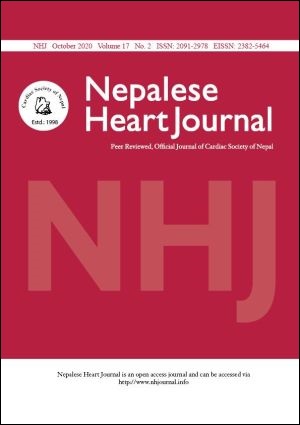Predictive Capacity of ACEF Score to Detect All-Cause Mortality and Post Contrast Acute Kidney Injury Among PCI Patients
DOI:
https://doi.org/10.3126/njh.v17i2.32674Keywords:
Contrast Induced Acute Kidney Injury, Contrast Induced Nephropathy, In-hospital Mortality, Short Term Mortality, 30-day MortalityAbstract
Background and Aims: ACEF score is simple risk score which uses only three parameters for predicting mortality and postcontrast acute kidney injury (PC-AKI). This study was designed to look into various risk factors and ACEF score for patients undergoing Percutaneous Coronary Intervention (PCI).
Methods: This is single-centre, observational, cross-sectional study. The patients were divided into tertiles.Bivariate analysis of various risk factors and ACEF score was done for PC-AKI as well as In-hospital and 30-day mortality.
Results: Total 257 patients were included.The total mortality among PCI patients were low: In-hospital (0.8%) and 30-day (1.9%). The risk factor for increased mortality were higher Killip class and reduced Ejection Fraction (EF). PCAKI occurred in one-fifth. The risk factors for PC-AKI were increasing age, higher Killip class, diabetes, reduced EF, emergency PCI procedure and higher contrast volume. Hydration with NS was protective against PC-AKI. Mean ACEF score was higher among those who died within 30 days (p=0.35) and who developed PC-AKI (p<0.001). ACEF-low had trend toward better outcome with no mortality (p=0.17) and had low risk of PC-AKI (p=0.026). ACEF-moderate had reduced risk of PC-AKI (p=0.029), however was not associated with increased odds of 30-day mortality (p=0.66). ACEF-high showed significantly increased odds of mortality (p=0.04) and PC-AKI (p<0.001). Discriminatory capacity of ACEF score to detect 30-day mortality was good (AUC 0.82, p= 0.016) and goodness of fit=0.70. Discriminatory capacity of ACEF score to detect PC-AKI was fair (AUC 0.7, p<0.001) and goodness of fit=0.62.
Conclusions: ACEF score fairly predicts the short-term mortality and PC-AKI in patients undergoing PCI.
Downloads
Downloads
Published
How to Cite
Issue
Section
License
This license enables reusers to distribute, remix, adapt, and build upon the material in any medium or format, so long as attribution is given to the creator. The license allows for commercial use.




